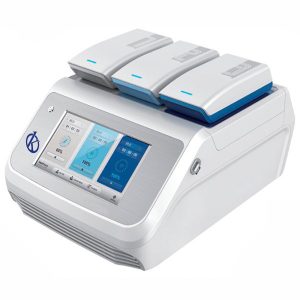The thermocycler is a device that allows the polymerase chain reaction (PCR) efficiently and quickly, by automatic and cyclical changes of temperature required for the amplification of a chain of deoxyribonucleic acid (DNA), from a thermostable enzyme.
Thermocyclers are used for qualitative amplifications or to quantify the amount of amplified DNA. The results of these DNA amplification techniques have a great impact on our society, especially in this period of pandemic where they have become one of the main diagnostic tests, reason why it must be ensured that the thermocyclers are accurate, accurate and uniform, in order to obtain reliable results.
What is polymerase chain reaction or PCR?
The polymerase chain reaction (PCR) is a technique that allows exponential amplification of a piece of DNA of interest. That is, from a low number of copies of that fragment, after the PCR reaction, millions of copies are obtained that are already easily detectable in the laboratory. The PCR was invented by Kary Mullis in 1986 and won him the Nobel Prize in 1993.
What is real-time PCR?
Real-time PCR is a modality of end-point PCR, where the accumulation of amplified DNA is detected and quantified as the reaction progresses, ie: “In real time” this is achieved by incorporating a fluorescent molecule that is associated with amplified DNA, where the increase of this fluorescence is proportional to the increase in the amount of amplified DNA molecules in the reaction.
Real-time PCR protocols can be designed to provide quantitative results as well as to demonstrate the presence or absence of a DNA or RNA fragment or quantitative results by calculating the number of copies of DNA, which when compared to a standard curve, sets the amount of microorganisms present in a given sample or to determine the number of molecules in an RNA to designate the expression of this for example.
Real-time PCR is a technique that combines amplification and detection in one step by correlating the PCR product of each cycle with a fluorescence intensity signal. They are composed of a thermocycler coupled to an optical system, which monitors the signal of the fluorophores used to detect the amplified product. Because the fluorescence of these increases as the product is amplified, the amplification and detection processes are combined in a single step.
This technique has important characteristics such as high specificity, wide range of detection and speed in the visualization of the product. Real-time PCR systems include a thermocycler and a unit capable of detecting fluorescent signals to monitor the progress of the amplification reaction, as well as software for data analysis. Fluorophores used to track DNA amplification during real-time PCR may be DNA-affinity (SYBR Green) or DNA-specific fragment probes (Taqman probes).
At Kalstein we are MANUFACTURERS and we offer you excellent thermocyclers with the most advanced technology and at the best PRICES. So we invite you to take a look HERE

